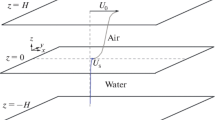Summary
The analysis of a pure drift current is presented, considering energy relationships, in addition to momentum relationships, originally treated by V. W. Ekman [1905]. The turbulent viscosity, varying with depth, is related to the kinetic energy dissipation, and is found to vary exponentially with the angle of rotation of the water velocity vector. The analysis is limited to fully-developed drift current, with fully developed surface wave system. Only a small part of the observable current velocity is found to be caused by the drift current, and most of it is due to the mass transport in waves. Almost the entire energy, transferred from the wind to water, is absorbed by waves, and very small part is absorbed by the drift current. In fully developed waves, about 2/3 of the energy is transmitted by normal air pressures on the wave surface, and about 1/3 is transmitted by tangential drag and the mass transport velocity. Present analysis yields the current velocity at the surface, and the form of the energy dissipation with depth, in reasonable agreement with available observational data.
Zusammenfassung
Die Analyse eines reinen Triftstromes wird dargestellt, wobei man zusätzlich zu den Impuls-Verhältnissen, die erstmalig von V. W. Ekman [1905] behandelt worden sind, auch die Energie-Verhältnisse berücksichtigt. Die turbulente Viskosität, die sich mit der Tiefe ändert, hängt zusammen mit dem Verlust kinetischer Energie. Es hat sich gezeigt, daß sie sich exponentiell ändert mit dem Rotationswinkel des Wassergeschwindigkeits-Vektors. Diese Analyse ist beschränkt auf einen voll entwickelten Triftstrom mit einem voll ausgereiften System von Oberflächenwellen. Man hat festgestellt, daß nur ein kleiner Teil der wahrnehmbaren Stromgeschwindigkeit vom Triftstrom verursacht wird und daß der größere zurückzuführen ist auf den Massentransport in den Wellen. Fast die ganze vom Wind auf das Wasser übertragene Energie wird von den Wellen, und nur ein kleiner Teil vom Triftstrom absorbiert. Bei voll ausgereiften Wellen wird 2/3 der Energie übertragen durch normale Luftdrücke auf die Wellenoberfläche und ungefähr 1/3 durch Tangentialschub und Massentransport-Geschwindigkeit. Aus der vorliegenden Analyse ergibt sich die Stromgeschwindigkeit an der Oberfläche und die Form des Energieverlustes in der Tiefe, in annehmbarer Übereinstimmung mit den vorhandenen beobachteten Werten.
Résumé
L'analyse, à l'origine traitée par V. W. Ekman [1905] d'un courant de dérive pure est exposée en considérant les relations d'énergie en plus des relations de moment cinétique. La viscosité de turbulence, variable suivant la profondeur, est rapportée à la dissipation de l'énergie cinétique et on trouve qu'elle varie exponentiellement suivant l'angle de rotation du vecteur vélocité de l'eau. L'analyse ne considère que le cas d'un courant pleinement formé avec un système de vagues superficielles pleinement formées. On trouve qu'une faible part seulement de la vélocité du courant observable est due au courant de dérive et que la plus grande part est due au transport de masse dans les vagues. Toute l'énergie transférée du vent à l'eau, est presque entièrement absorbée par les vagues et, pour une part très faible, par le courant de dérive. Dans un système de vagues pleinement formées, les 2/3 environ de l'énergie sont transmis par des pressions d'air normales sur la surface des vagues, et 1/3 environ est transmis par entraînement tangentiel et la vélocité de transport de masse. La vélocité du courant en surface et la forme de la dissipation d'énergie en fonction de la profondeur, telles qu'elles résultent, de la présente analyse, sont en concordance acceptable avec les données fournies par l'observation.
Similar content being viewed by others
References
Bierens de Haan, D., 1957: Nouvelles tables d'intégrales définies. New York.
Bye, J. A. T., 1967: The wave drift current. J. mar. Res.25, 95.
Defant, A., 1961: Physical Oceanography. Oxford.
Dobroklonsky, S. V., 1969: Drift currents in the sea with an exponentially decaying viscosity coefficient. [In russ. Spr.] Okeanologija9, 26.
Durst, C. S., 1924: The relationship between current and wind. Quart. J. R. met. Soc.50, 113.
Ekman, V. W., 1905: On the influence of the earth's rotation on ocean currents. Arch. Matematik, Astronomic, och Fysik (Stockholm)2, 1.
Garrett, J., 1969: Some new observations on the equilibrium region of the wind-wave spectrum. J. mar. Res.27, 273.
Hughes, P., 1956: Determination of the relation between wind and sea surface drift. Quart. J. R. met. Soc.82, 494.
Kenyon, K. E., 1969: Stokes drift for random gravity waves. J. geophys. Res.74, 6991.
Kitaigorodsky, S. A., 1961: To theory of turbulent mixing at sea in connection with calculation of the thickness of the upper isothermic layer. [In russ. Spr.] Trudy Inst. Okeanol.52, 3.
Korvin-Kroukovsky, B. V., 1965: Balance of energies in the development of sea waves, semi-empirical evaluation. Dt. hydrogr. Z.18, 145.
Korvin-Kroukovsky, B. V., 1966: Air pressures causing wave development, estimate by theory, model tests, and sea observations. Dt. hydrogr. Z.19, 145.
Korvin-Kroukovsky, B. V., 1967: Further reflections on properties of sea waves developing along a fetch. Dt. hydrogr. Z.20, 7.
Korvin-Kroukovsky, B. V., 1969: The dissipation of energy in wind-generated waves: a hypothesis. Dt. hydrogr. Z.22, 97.
Neumann, G., 1968: Ocean currents. Amsterdam.
Ozmidov, R. V., V. S. Belyaev, A. D. Yampolsky, 1970: Some features of the turbulent energy transport and kinetic energy transformation in the ocean. [In russ. Spr.] Izv. Akad. Nauk SSSR, Fiz. Atmosf. Okeana6, 285.
Schmidt, W., 1917: Wirkungen der ungeordneten Bewegung im Wasser der Meere und Seen. Ann. Hydrogr. mar. Met.45, 367.
Schuleikin, W. W., 1960: Theorie der Meereswellen. Berlin.
Stewart, R. W., 1969: The atmosphere and the ocean. Scient. Amer.221, 76.
Thorade, H., 1914: Die Geschwindigkeit von Triftströmungen und die Ekmansche Theorie. Ann. Hydrogr. mar. Met.42, 379.
Wu, J., 1969: Wind stress and surface roughness at air-sea interface. J. geophys. Res.74, 444.
Author information
Authors and Affiliations
Rights and permissions
About this article
Cite this article
Korvin-Kroukovsky, B.V. Pure drift current and mass transport in coexistent waves. Deutsche Hydrographische Zeitschrift 25, 1–13 (1972). https://doi.org/10.1007/BF02226379
Received:
Published:
Issue Date:
DOI: https://doi.org/10.1007/BF02226379




